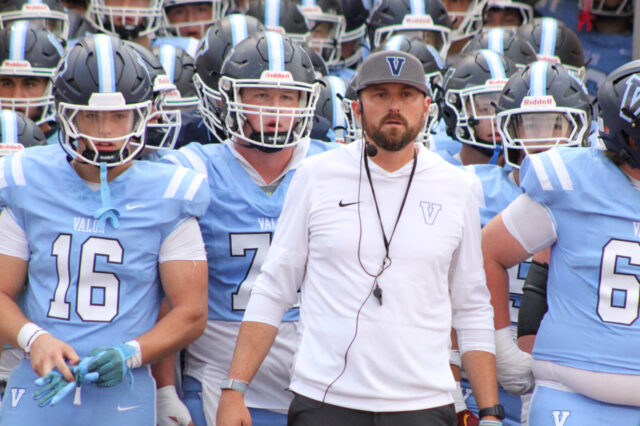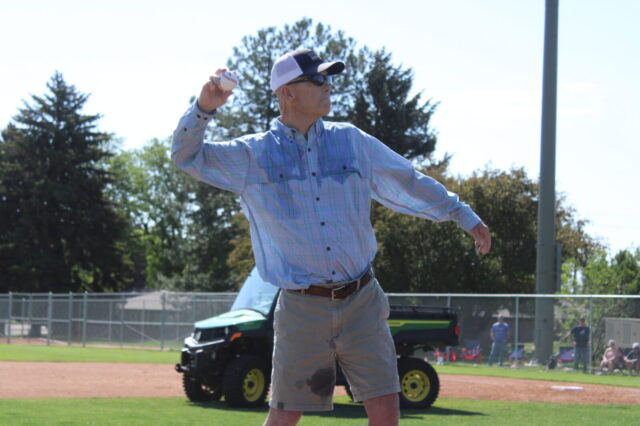Earl Boykins is still the shortest guy on his team.
That is not necessarily a new headline for the 5-foot-5 former NBA veteran, but considering that he’s now surrounding himself with 16 and 17 year olds from Douglas County High School in Castle Rock, Colorado, where Boykins is just finishing up his second year as head coach, it’s important to note.
Regardless of stature, though, Boykins is easily the most imposing presence in the gymnasium. And in his team’s first game of the new year, it shows, as Boykins’ voice rings louder than the game-clock buzzer itself.
The Huskies, sitting at 4-3, are facing off against the Brighton Bulldogs. With 10 seconds left in the game, and the hometown Huskies down 50-49, the Bulldogs have committed the unthinkable by fouling the Huskies’ point guard. Hit one free throw and the game is tied. Drain two and the team has a great chance at matching its 2014-15 win total of five with 15 games left in the season.
The first free throw clangs off the rim and bounces straight back to the shooter. The gym grows eerily silent and the tension is excruciating. As the second free throw arcs through the air, it looks so much prettier than the last. As the ball comes down, it rolls around the rim until the heartbreaking laws of gravity finally bring it clamoring back down to earth. The beauty was only a facade, though, as the Bulldogs took the ball full court for the easy, game-winning layup.
Although the loss was a difficult one for him and the team, Boykins can already see a difference in the confidence with which his student-athletes play.
“Last year we were uncertain,” Boykins said. “There was a new system. This year they seem more comfortable.”
Boykins is coaching with much more confidence as well. He said the biggest thing he has learned from last year is the fundamentals of practice. Where last year the team was scrimmaging a lot, now Boykins is able to work on drills more often to increase the speed of development for his players. Boykins’ goals for this year’s team are already being realized.
“I just want these guys to continue to play hard no matter what the outcome is,” he said. “To compete. If we continue to compete the way we did tonight, we will win our fair share of games.”
Let’s leap to a time when no one is thinking about high school basketball, except Earl Boykins.
Coach Boykins is sitting in the Douglas County gym on a spring evening in early April 2015, looking pensive and reflective. His voice is much calmer and relaxed. He is observing his students in the open gym, practicing with his assistant coaches, working on fundamentals for next season. On the other half of his gym are fourth through eighth graders in the Boykins Basketball Academy learning the game. There is no offseason for this coach.
His persistence and dedication may stem from the dissatisfaction he carried away from the 2014-2015 season. When the last buzzer echoed through the arena, it left a lasting impression on Boykins.
“When that last second ticked off there was a sadness,” Boykins said. “I felt like we could have achieved more. As a coach and as a player I’ve never been satisfied. Every year when the buzzer goes off, I looked at it as time to get ready for next year. That is how I view everything. When one thing ends, it’s on to the next one.”
When Boykins’ professional career ended, he said he always wanted to coach. This was partly inspired by his father, who still coaches at the elementary school Boykins grew up in.
“My dad has been coaching for almost 40 years,” he said. “So teaching the game has sort of always come naturally to me. It’s something that I’ve wanted to do because I love teaching. Helping someone get to their goals is always a good thing.”
But Boykins’ goal of coaching wasn’t always a sure thing, even for a former professional athlete. Boykins only had two interviews and Douglas County athletic director Jeff Gardella was the only one to call back.
“I knew (Boykins) was the right candidate after he described the obstacles that he constantly faced throughout his life. Especially how it pertained to basketball and how he was always told he would never be able to achieve anything because of his size,” Gardella said. “He was constantly told, ‘You can’t do this, or you won’t make this team.’ He proved a lot of people wrong due to his work ethic and belief in himself.”
Gardella said the growth he has seen in the program since Boykins’ arrival includes faster team play, more knowledge (especially defensively) and a belief that they can be good.
“In my five and a half years here, I’ve always been told Douglas County will never be competitive in basketball. So after hearing about Coach Boykins’ journey, it just made sense to me that if anyone can turn this program around and erase the stigma attached to it, it was a 5-foot-5, 133-pound, 15-year professional player, college graduate, Final Four participant that beat Duke, very humble guy.”
That one phone call happened to be an excellent fit with the type of impact Boykins wanted to generate in a basketball program. Boykins said he wanted to come to Douglas County because he wanted the opportunity to develop his own program and not piggyback off someone else’s legacy. That order is a tall one considering this school is traditionally known for its football program.
“I want to make this a basketball school,” Boykins said. “I know it has a great football tradition and not so much in basketball. My goal is to change that. My goal is to get people to look at Douglas County as a legit basketball program around the state.”
When Boykins took the job in 2014, the team wasn’t coming off a great year. Boykins’ first year didn’t do much to change that. The team had a record of 5-18 and didn’t have a single win in its league. Boykins said he didn’t have any expectations coming into his new role, as he had only watched two Colorado high school basketball games in his life. He didn’t even know the conference before this job.
“My approach to basketball is it doesn’t matter where you play,” he said. “I just worry about my team. It’s not about who we are playing. It’s about us. The biggest thing I learned from last year at this time was I didn’t know how to prepare kids to play how I want them to play. Now I actually know what I have to instill. I couldn’t know that last year.”
Boykins did not change the perception of basketball at Douglas County in a year, but he did find a bright spot. That came from growth in perception he didn’t necessarily realize growing up.
“These guys taught me patience and they brought back the love I had for the game before I became a professional player,” Boykins said. “They brought back the fun in the game. This group taught me patience and success isn’t gauged with wins and losses. Because coming from where I come from, it’s all about winning and losing. Where I come from, if you don’t win, you don’t feed your family.”
Boykins comes from the east side of Cleveland, Ohio. Growing up, affluence wasn’t necessarily related to dead presidents.
“The way I valued money growing up was if you had some Jordans, you were rich,” he said, laughing.
Based on that standard, Boykins was certainly a rich kid, but when he was playing at Central Catholic High School, the city of Cleveland measured riches in terms of basketball. Ruben Patterson and James Posey, both from Cleveland, made it to the NBA. There were two other Division I players on Boykins’ high school team.
“Basketball is always a foundation [back home.] It’s not as big as football of course, but games there are always packed. You are always going to play against great competition night in and night out.”
Boykins was hired at Douglas County around the same time LeBron James returned to play for the Cavaliers. Boykins has profound respect for how James is changing and inspiring his hometown. The inspiration Boykins provides is for those who are told they can’t their whole life.
“I just always knew that I could play in the NBA because the game was never hard for me,” Boykins said. “The hardest part about the NBA was overcoming other people’s prejudice about my height and size. I overcame that by just performance alone. I was viewed as a player who shot the ball a lot. My response to that was if you’re a player who is 5-foot-5 and average four points and two assists, you don’t play more than 30 games total in the NBA. Now if you average 14 points a game, then people recognize you. So my standards have always been different from everybody else’s.”
This me-against-the-world-Tupac mentality has made him the imposing and inspirational presence he is today, and it has transitioned to his coaching techniques by teaching aggressiveness, up-tempo basketball and man-to-man principles. When asked if he is trying to channel his former Nuggets coach George Karl, Boykins just laughs it off.
“In order to play that way, you have to have George Karl type players,” he said. “We definitely want to play up-tempo though, and give our players favor.”
Douglas County may not have any Oak Hill Carmelo Anthonys on the court, but they do have guard/forward C.J. Cetta. The senior has played for Coach Boykins the last two seasons and has developed a leadership role on the team. Cetta said the first year playing for a former NBA player he was a little bit nervous and he didn’t want to embarrass himself.
“Once I realized all he is here for is to get us better and he has the best interest for us, I just sold out,” Cetta said. “The main thing Coach instilled in me is playing my hardest all the time. Always competing.”
There is that word again. Earl Boykins has always been an outcast in this world. But that has never been an excuse not to compete. A historically poor basketball program is not an excuse not to compete. It’s an opportunity.
Boykins doesn’t perceive any pressure from the community in having expectations of a former professional bringing a winning program to town.
“I don’t believe in pressure. There is no pressure in basketball. There are only opportunities. Opportunity to be successful as a player and as a coach. Pressure is something you can only apply to yourself.”
Even though the season ended with a losing record, the team did improve from Boykins’ first season. The record, though, pails in comparison to his main goal of teaching kids.
“I love being a coach. The amount of teaching and difference you can make in a kid’s life is unbelievable,” he said. “I’ve always looked for something that allows me to give back. This is the perfect match.”
How does coaching young athletes compare to a NBA career?
“It’s totally different. The NBA is strictly a job,” Boykins said.
This isn’t a job for you?
“No. It is definitely more fun.”
Who said competing couldn’t be all fun and games?
(Featured image courtesy of Karl Gehring of The Denver Post)



